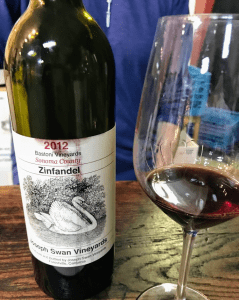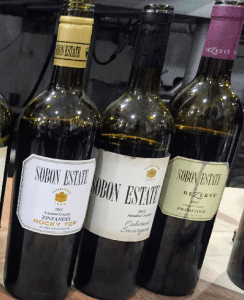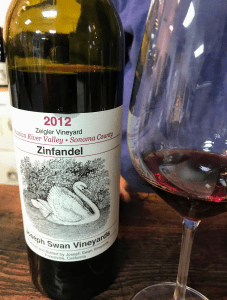For a de facto Zin-ful Thoughts Part II see my post Zinfandel — The “Craft Beer” of American Wine

Joseph Swan Zinfandel from the Bastoni Vineyard in the Fountaingrove District of Sonoma County.Originally planted in 1906, the vineyard was significantly replanted in 2005.
I must confess that being based in the Pacific Northwest and a bit of a Francophile, my experience with Zinfandel has been limited—mostly the uber jammy and commercialized examples from producers like Rombauer, Michael David and Klinker Brick. We do grow a little bit of the variety here in Washington State (65 acres as of 2017) but many of the examples that I’ve tried have been a bit underwhelming.
A trip last year to Joseph Swan Vineyards in Sonoma started to change my perception of Zinfandel. Here I found examples of this “big bruising grape” that were elegant, spicy and downright mouthwatering. So I was very intrigued to read Caparoso’s post and ended up learning a lot.
Some of the cool things (not all Zin related) I learned from Caparoso’s post:
1.) One of the reasons why Zinfandel likely became such a popular and widely planted grape in California during the 1800s was because of how easy it is to grow, particularly in the goblet “bush vine” style. Growers could just stick cuttings into the ground, without the expense and labor of trellising, and tend to the vine with the relatively low-maintenance spur-pruning system. Add to the fact that Zin produces reliable yields, it makes sense why this was a choice variety for many of the European immigrants who planted the early California vineyards.
2.) Due to the decline in popularity of White Zinfandel, overall plantings of Zinfandel have decreased which means that when the 2017 USDA acreage report comes out, it will likely show Zinfandel as the 4th most widely planted wine grape in California behind Chardonnay, Cabernet Sauvignon and Merlot. I wouldn’t shed a tear for desperate housewives as pink Moscato is there to fill their empty glasses. I’m sure Zinfandel fans are not going to mind.

I appreciated how the Sobon Primitivo was full bodied with rich dark fruit without being overtly jammy.
The Rocky Top was spicier and more my style but the Primitivo had it charms.
3.) While Buena Vista, established in 1857 in Sonoma, is widely credited as being the first commercial winery in California, that honor actually belongs to the Vignes Winery that was established in Los Angeles in 1833 by Jean-Louis Vignes. In the Zin hotbed of Amador County, d’Agostini Winery was founded a year before Buena Vista in 1856 with the cellars and vineyards now owned by Zinfandel specialist Sobon.
4.) While currently terms like “Old Vine” and “Ancient Vine” are unregulated and can apply to anything that a winery’s marketing team wants it to, there is a movement in Lodi and other Zinfandel regions to adopt something similar to the Barossa Old Vine Charter. This charter established designation of 4 tiers of “old vines” covering a span of vine ages. On the LoCA FAQ, Caparoso gives his suggestions on tiers beginning with ‘Old Vines’ denoting vines at least 50 years of age going up to ‘Historic Vines’ that are over a 100 years of age.
5.) It’s hard to define a “Lodi-style” of Zinfandel because many of the region’s largest producers (like Michael David & Klinker Brick) tend to produce a very commercialized style of Zinfandel that often sees a significant portion of Petite Sirah blended in as well as judicious oaking.
My Zin-exploration plans for the year

Located across the street from the Mancini Ranch (notably used by Carlisle), the vines here are over 100 years old
I want to explore more terroir driven examples from vineyard designated bottlings of Zinfandel. At Joseph Swan, in addition to trying their Bastoni Vineyard pictured above, I also got a chance to taste a bottling from the Zeigler Vineyard in the Russian River Valley. This one had a intriguing floral smokiness to it that I didn’t find in the more peppery Bastoni. It was almost as if a Pinot noir and Syrah had a baby. It was very fun trying these two Zins side by side. They had a streak of similarity but were very different.
I also want to hunt for this elusive “Lodi-style” that is hiding under the shadows of the area’s big producers. I’ve had the opportunity to try wines from St. Amant Winery that Caparoso highlights as one of Lodi’s Zinfandel specialists. Here, again, trying two different vineyards side by side was incredibly fascinating with the century plus vines of their Marian Vineyard (planted in 1901) showing spicy, dark fruit notes while the Mohr-Fry (planted in 1945) was more more berry fruit and floral.
Some of these differences could be terroir, some could be vine age. I want to learn more about that.

A Crljenak Kaštelanski vine from the village of Kaštel Novi in Croatia. Read the Wikimedia Commons link for some more fascinating info about this vine from the photographer User:Amatulic!
A holy grail of geekdom for me would be to get my grubby little hands on a Croatian Zinfandel. When I visited Croatia in 2016, I was quite disappointed in that all I could find among reds was Plavac Mali, which was a tasty grape but no Crljenak Kaštelanski.
Finally, I want to keep a more open mind about Washington (and Southern Oregon) Zinfandel. I have a hunch that two factors that have been driving their (in my opinion) underwhelming style has been a combination of very young vines (I couldn’t find any info on what is the oldest planting of Washington Zin but I would be shocked if it was more than 25 years) and that many winemakers here haven’t figured out what they want to do with the grape yet.
We produce so many exceptional red wines from varieties like Cabernet Sauvignon, Merlot and Syrah that I feel like producers are throwing the techniques that have made those wines successful against the wall and seeing what sticks. A Zin that taste like an oaky Cab or a more alcoholic version of Syrah is not very appealing. On the flip side, Washington-versions of the jammy commercialized Zins aren’t very exciting either.
The art of winemaking involves a lot of trial and error so this seems like something that will work itself out. There are just too many talented winemakers in the Pacific Northwest to think that someone is not going to hit on something delicious when it comes to Washington Zinfandel.
Till then, I’ll keep my eyes open and drink up where I can.
